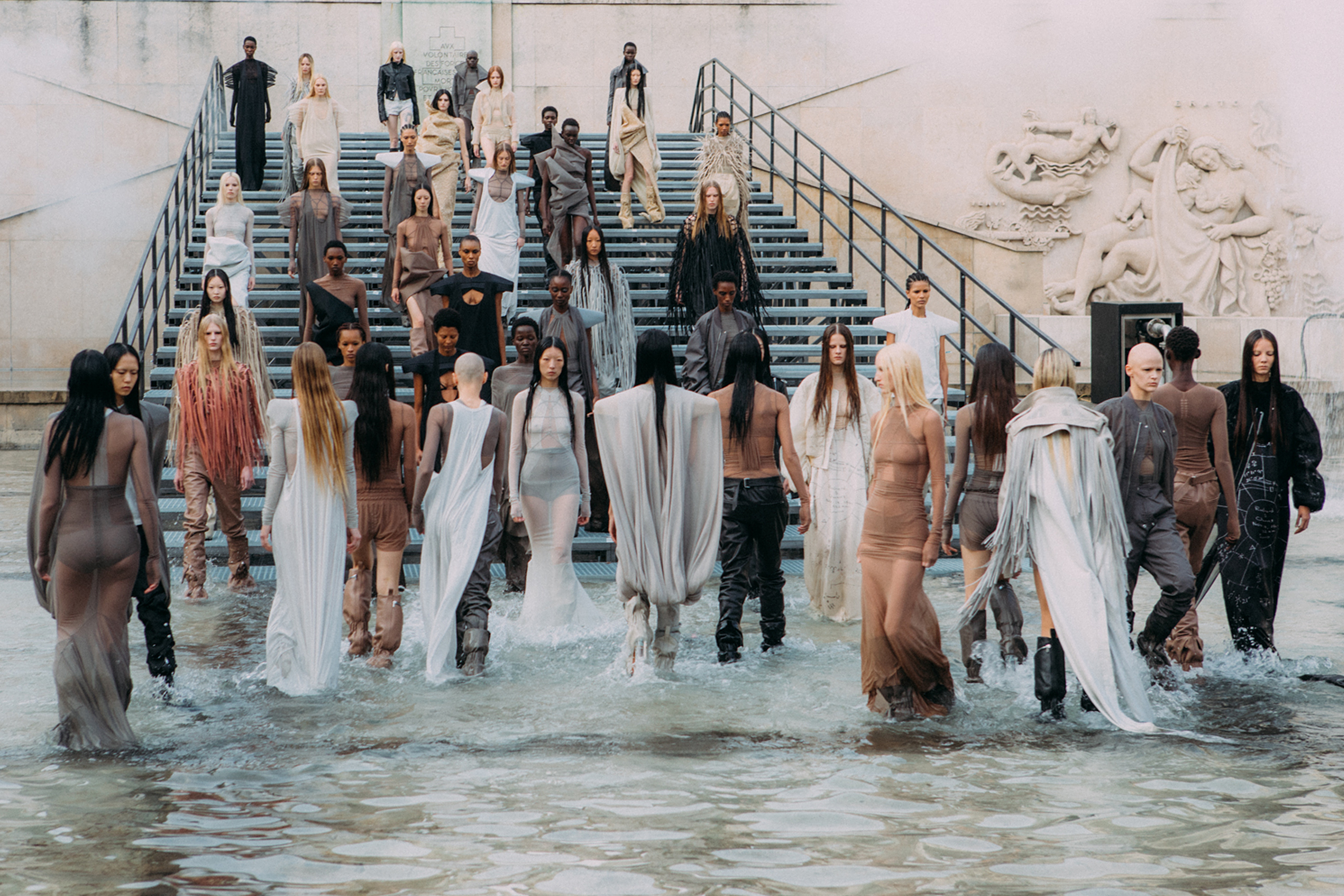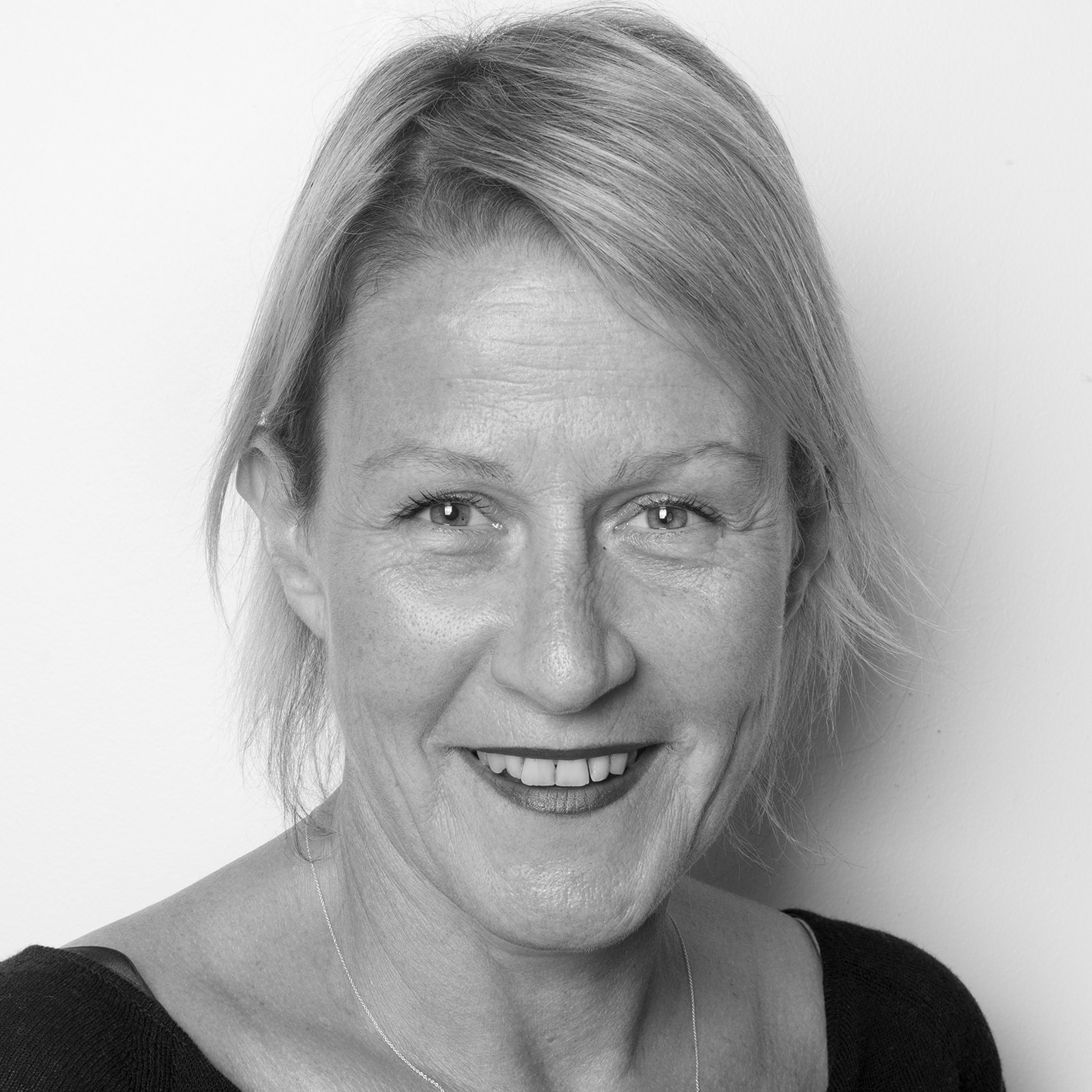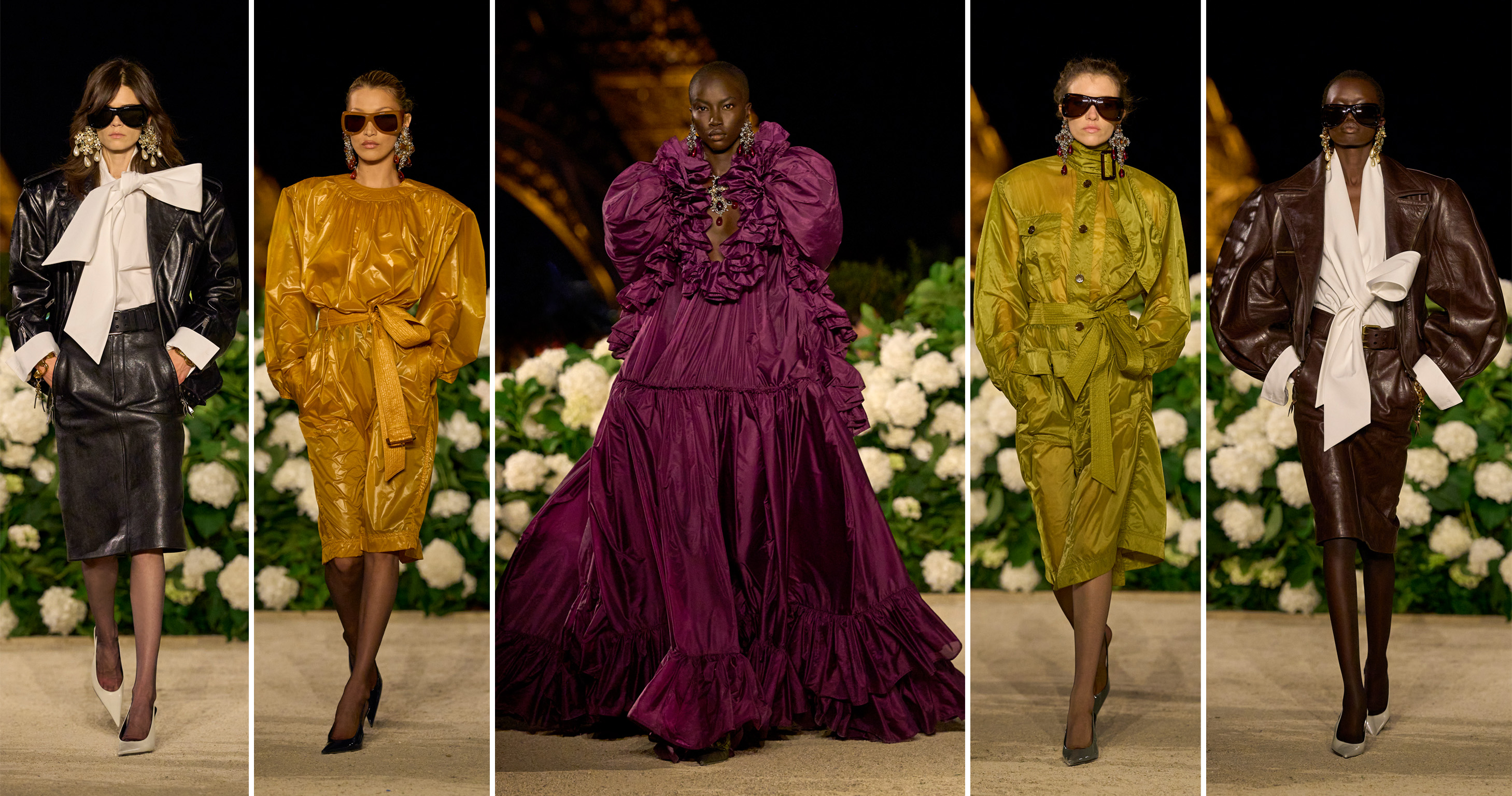
Saint Laurent
Beneath the sparkling lights of the Eiffel Tower, amongst a flood-lit French garden set of white Hydrangeas (drone footage revealed it to be a supersized YSL logo), creative director Anthony Vaccarello’s latest show remained true to the original codes of the house during the 70s and 80s. Opening with a series of white low-tied pussy-bow blouses, their ties dramatically oversized, worn with leather pencil skirts and differing iterations of the leather jacket, silhouettes were strong-shouldered, some with voluminous sleeves, others belted and brimming with a provocative femininity. Models hands were shoved defiantly into pockets and bags were nowhere to be seen, instead replaced by chandelier earrings, layered charm bracelets and oversized sunglasses. Signature Saint Laurent raincoats and day dresses were reimagined in multiple shades of body-clinging, semi-sheer technical fabrics. Closing looks saw a stream of quick-paced models in feather-light billowing ruffled, puff-sleeved dresses that came in an endless colour.
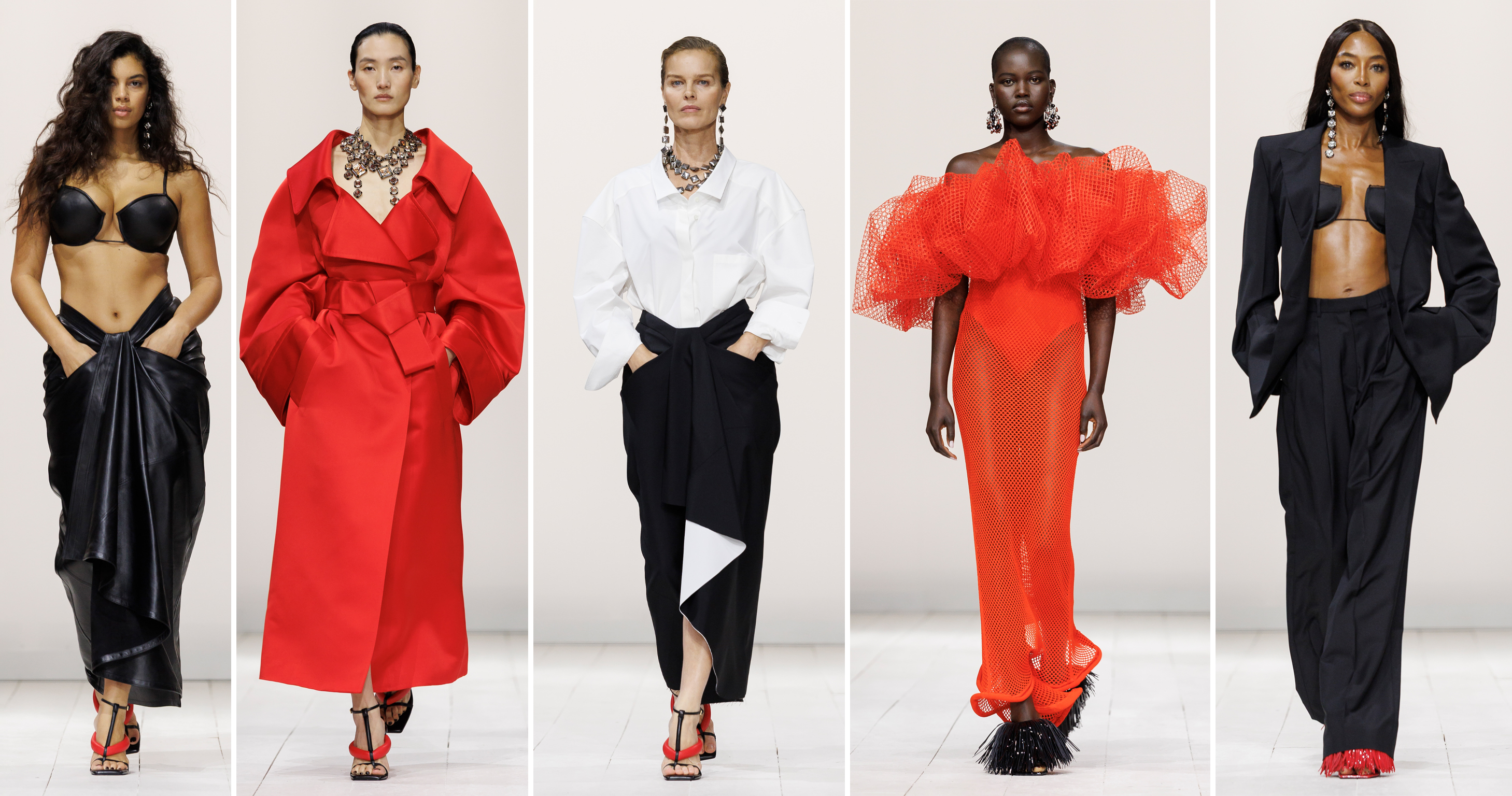
Givenchy
This was Sarah Burton's second season at Givenchy and the British designer has found her stride. Backstage Burton explained, “I was looking at female power and how to empower women through the archetypes of the feminine and the iconography of the female.” Inspired by the photographs of Swiss photographer René Groebli’s wife, Rita, taken during their honeymoon in 1954, Burton used those private moments as fuel for her powerful and sexy collection. One look was a structured bra teamed with a wrap skirt, Burton took tailoring and the dress and accentuated the curves. Sometimes revealing a lot of skin with spaghetti straps and high hems on dresses, sometimes revealing more of flash by taking a shirt and slicing down the front to expose the collarbone, achieving looks that were both erotic and sensual. Elongating proportions of the body with crisp tailoring whose construction was stripped back to create a lightness that mirrored the dresses that were softened further with ballerina pumps. A strong cast of models, including Mariacarla Boscono, Eva Herzigova, Alex Consani and Naomi Campbell brought character. Burton explained: “It's about taking each woman as an individual. I don't design for one woman, I design for women.”
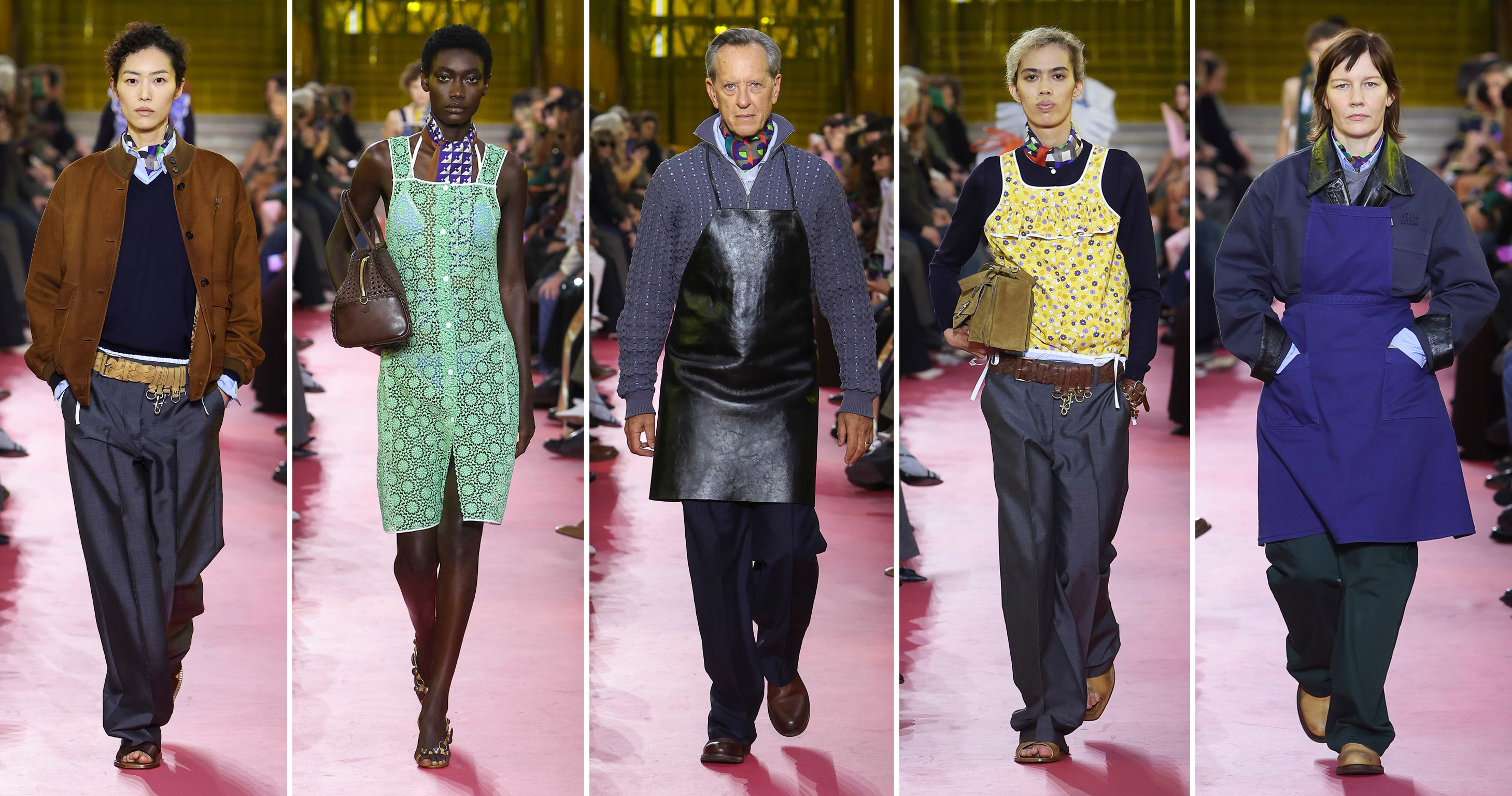
Miu Miu
Miuccia Prada’s muse for SS26 was working-class women and homemakers. The set consisted of canteen-style Formica tables, doubling as seating, lining the red linoleum runway. Actor Sandra Hüller opened the show wearing a navy cotton drill apron over a donkey jacket and blue shirt. Elsewhere in the collection, apron dresses riffed on retro house coats from a bygone era (think Hilda Ogden and Nora Batty) in bright ditsy floral prints and pastel corded lace. Fetishising blue-collar workers in luxury fashion often sits uncomfortably, here Mrs Prada defended the decision telling Vogue that “to me the apron contains the real difficult life of women in history, from factories to the home,” and stated in her show notes that the collection was “a consideration of the work of women – their challenges, adversity, experience. Its invisibility is confronted and addressed, recognised and valorised.” It made for very relatable clothes – suede Harrington jackets, utility belts with clips for keys, multi-pocketed handbags and the aforementioned aprons – a universal symbol of work. All presented and championed through Mrs P's fiercely feminist female gaze. Shout out also for age diverse casting, including actor Richard E Grant, musician and composer Daniel Blumberg, singer and sound artist Phew and choreographer and director Celia Rowlson Hall.
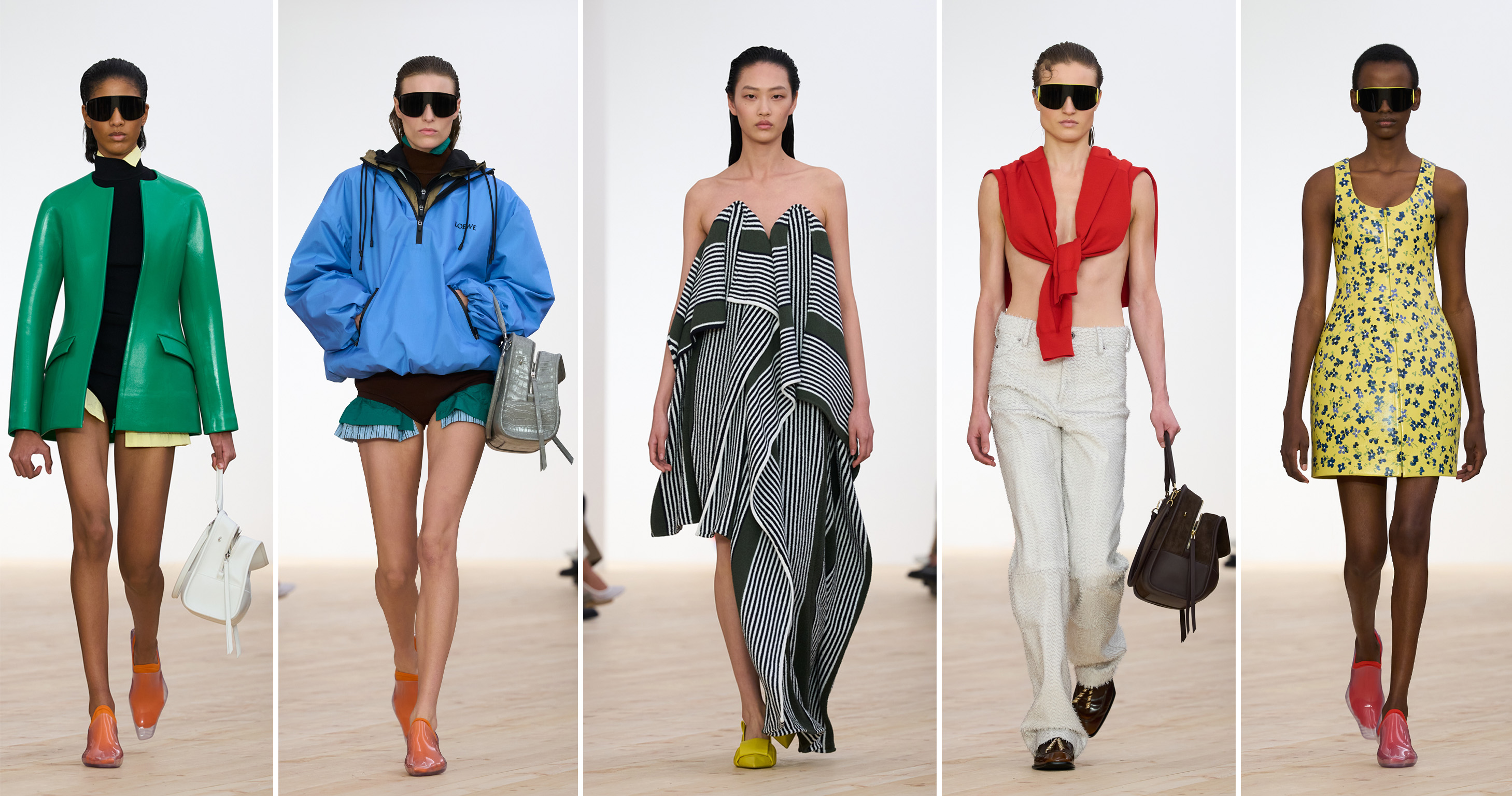
Loewe
Second only to Matthieu Blazy's show-stopping debut at Chanel, Jack McCollough and Lazaro Hernandez’s debut for Loewe received one of the most effusive reactions of the SS26 season. The New York-raised design duo executed a masterclass in craftsmanship for their first collection, taking over from the former creative director Jonathan Anderson, these were big shoes to fill, but the duo hit their stride perfectly. With the backdrop of a drizzling rainy Paris the audience were welcomed into a cube within the grounds of the Cité Internationale Universitaire de Paris. Opening on a simple jumper tied around the neck with nothing underneath and shredded leather jeans, then came the pops of bold primary colours in the form of exquisite leather jackets and mini dresses that held sculptural forms. Sweeping asymmetric skirts followed bandeau dresses, while bomber jackets were paired with barely there hot pants, big knickers is a definite trend. McCollough and Hernandez have developed their own Loewe towel dress that came in several colourways. A seaside theme was unravelling as soft canvas sun hats topped the models heads and colourful windbreaker-esque striped maxi-dresses and colourful silk windbreakers completed the duo's vision of a seaside wardrobe.
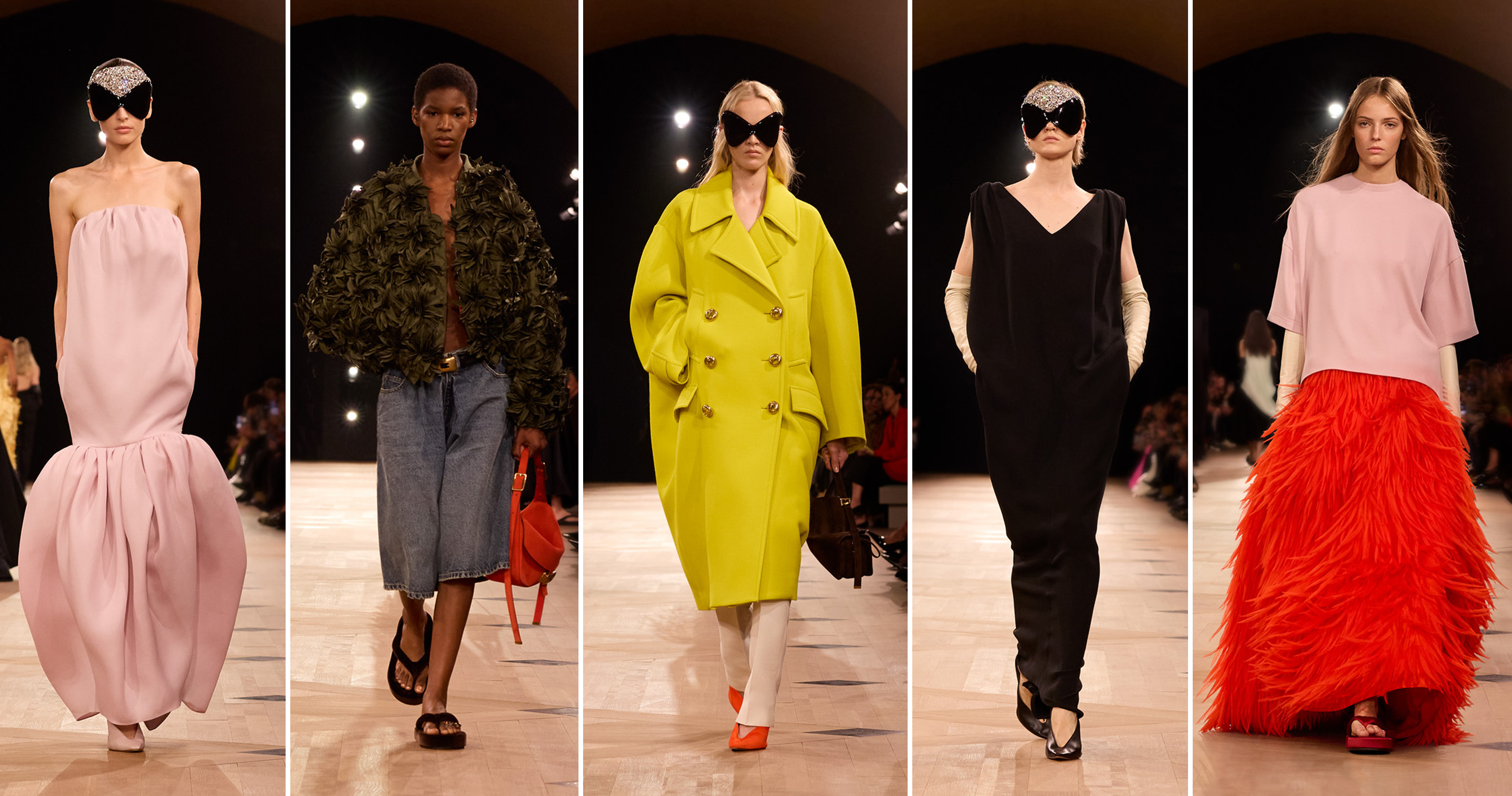
Balenciaga
Another of the big debuts this season came from Pierpaolo Piccioli at Balenciaga who succeeded Demna, who left for Gucci in July. Described as a recalibration not a homage to the work of Cristobal Balenciaga. Piccioli referenced the early work of the couturier along with that of the creative directors that went before him. A visit to Getaria, the birthplace of Balenciaga, gave him the opportunity to see an archive film from 1957 of a woman wearing the “sack” dress on the streets of Paris, the dress was revolutionary for its time, unstructured with only two seams. Piccioli took the dress as a starting point opening with a version of the look paired with the wraparound bug-like shades associated with Demna’s Balenciaga. Backstage, Piccioli explained he “wanted a sense of freedom” in the clothes, “when you see the movement you really understand how architectural Balenciaga was”. The bold volume often present in his work found a natural caretaker in Piccioli who caused his own sensation during his tenure at Valentino with his vivid voluminous silhouettes. For SS26, he applied that scale to bubble-shaped leather jackets, chinos, tunic T-shirts, overcoats and a white shirt with a full train. Embroideries of flower and feather elements further delved into couture techniques and hinted at what might come in January for the haute couture collection.
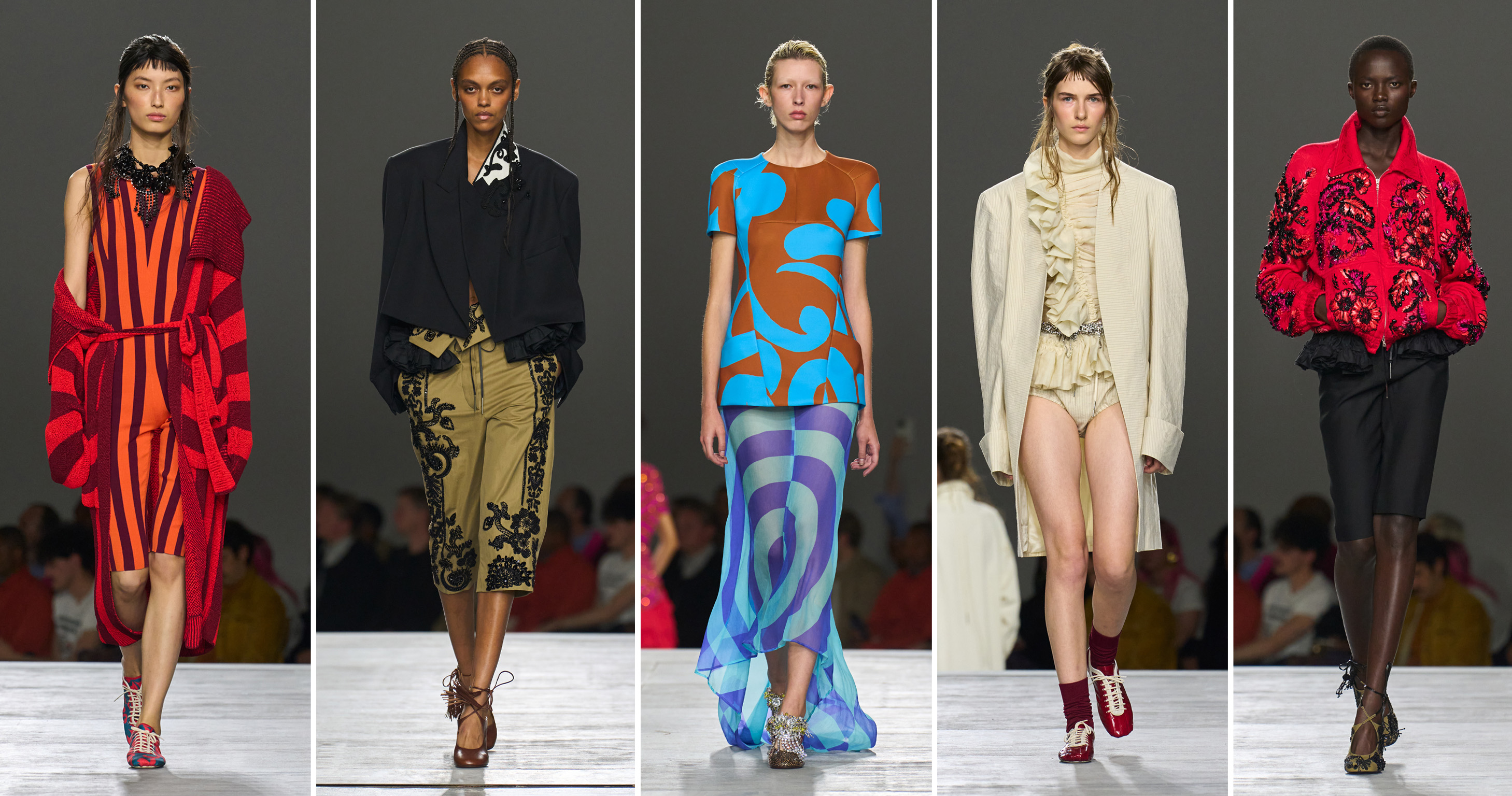
Dries Van Noten
Creative director Julian Klausner’s SS26 show started with summer holidays and surfing, titled Wavelength. The concept for the show first came to Klausner when he was “watching the sunset on the beach,” he explained. “Observing surfers in the waves, I was struck by how elegant the silhouette of a wetsuit is.” Inspired by the colour and shapes and the contrast of a stiff surfboard against the delicate ruffles of foaming water led the designer to experiment with scale, colour and form. Beginning with a white coat, drifting into cloudy greys and soft neutrals, gradually building to vibrant pops of red, lime green and bubblegum pink. Inspired by the body skimming silhouette of a wetsuit, suits were cut narrow at the shoulders and the legs, so too were printed board shorts, which Klausner teamed with peplum tops, wave-like ruffles appeared on jackets and shirts and edged cute knickers. Sarong skirts and kaftans in fluid washed silk mousseline were married with structured bomber style and tailored jackets while prints appeared both graphic and bold, some decorated with embroidered jewels others placed in the house style of an eclectic mix of print and colour.
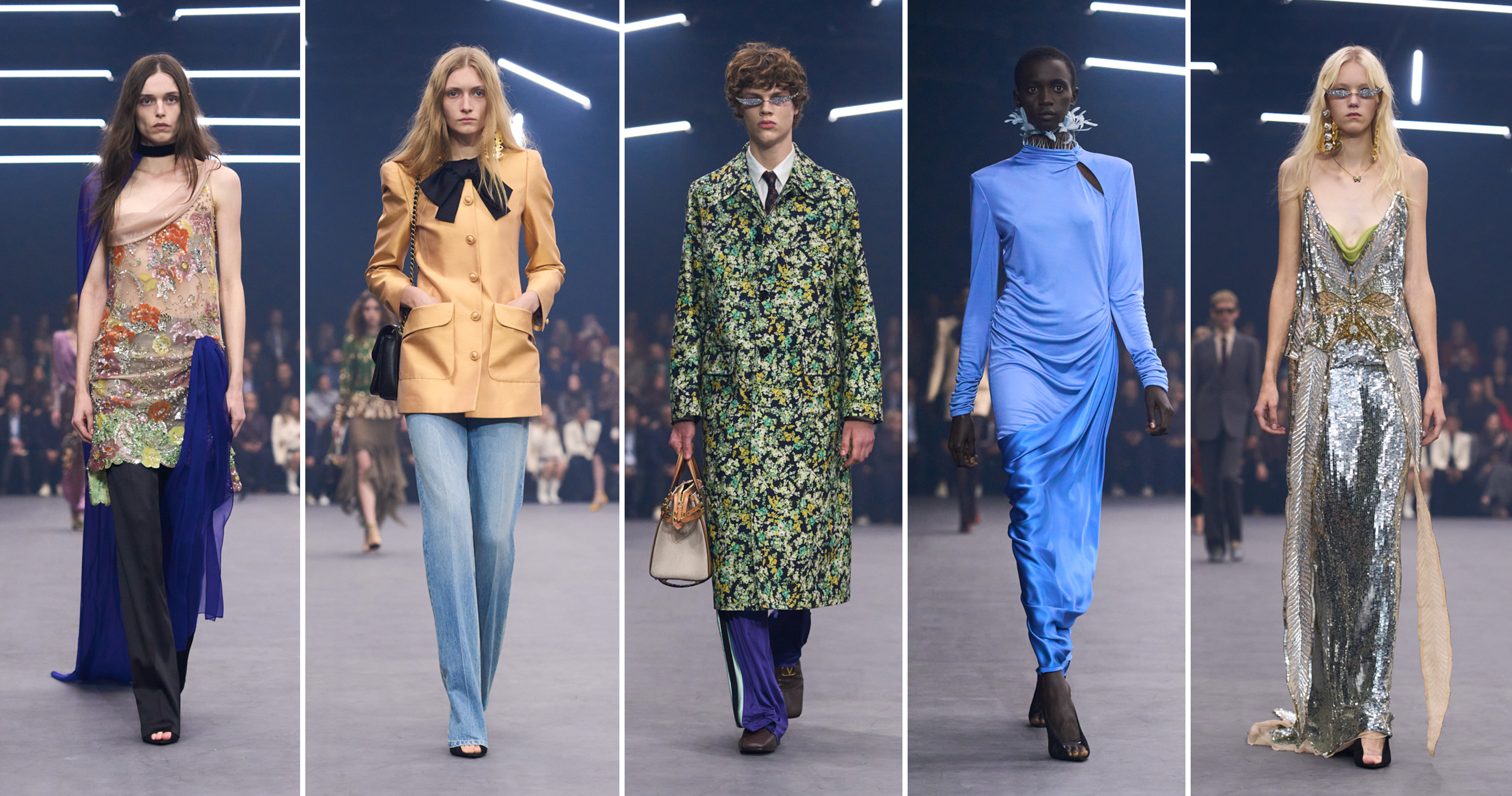
Valentino
Notably this season there have been almost no political statements from big brands or designers. The only mention of real life came from Alessandro Michele at Valentino who called out fascism in a manifesto for his Fireflies show. Quoting a letter from writer and director Pier Paolo Pasolini to his college friend in 1941 during the Second World War that recounted a story about fireflies which represented, in his eyes, the ability to resist the darkest night: “Glimmers so elusive to survive the darkness of the ruling fascism.” The letter was read out in a voiceover by Pamela Anderson. Fashion wise the looks were less embellished than previous seasons, jolts of rich block colour ran through the collection, across men’s and womenswear; a deep purple embossed coat dress was shown with oversized jewelled earrings and a long-sleeved forget-me-not blue draped dress was undecorated aside from a delicate feather stand-up collar. Magpies need not worry, though, there was still plenty of sparkle in a deco style top, floral dress worn over narrow trousers and two Zelda Fitzgerald-esque sequin dresses. At the end of the show, all the models assembled on the square runway as the house lights dimmed, gazing up at the flickering Fireflies (spinning lights) in a thoughtful tableau.
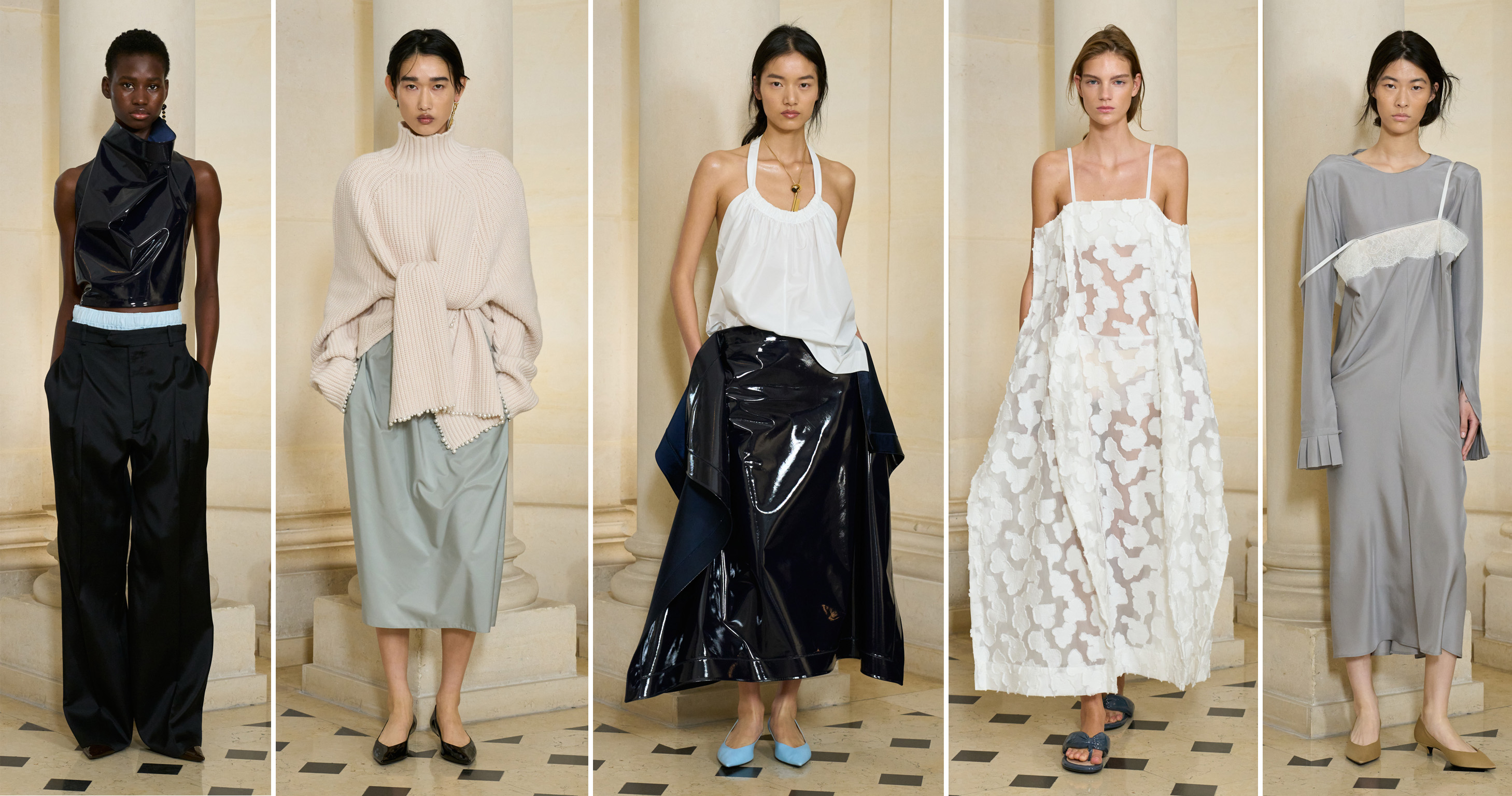
Carven
Mark Howard Thomas’s collection for Carven saw yet another debut. The British-born designer has stepped up to fill the shoes of his former boss, Louise Trotter, who moved to Bottega Veneta, debuting last week in Milan. Thomas's show took place in the courtyard of the house’s Paris HQ, continuing with the codes of the house that has won the label a loyal following. Refined minimal silhouettes, focused on masterful cuts, minimalist lines and delicate sensual fabrics, continuing with the founder Marie-Louise Carven’s love of white orchids for his colour palette and detail. Dresses appeared in delicate petal appliqué voile and abstract flower silhouettes created from folds and draping to add structure to skirts, tops were cut to add fluid lines that revealed the back, while sophisticated, easy-to-wear sportswear pieces added a foundation to the collection. This was a collection brimming with French savoir-faire.
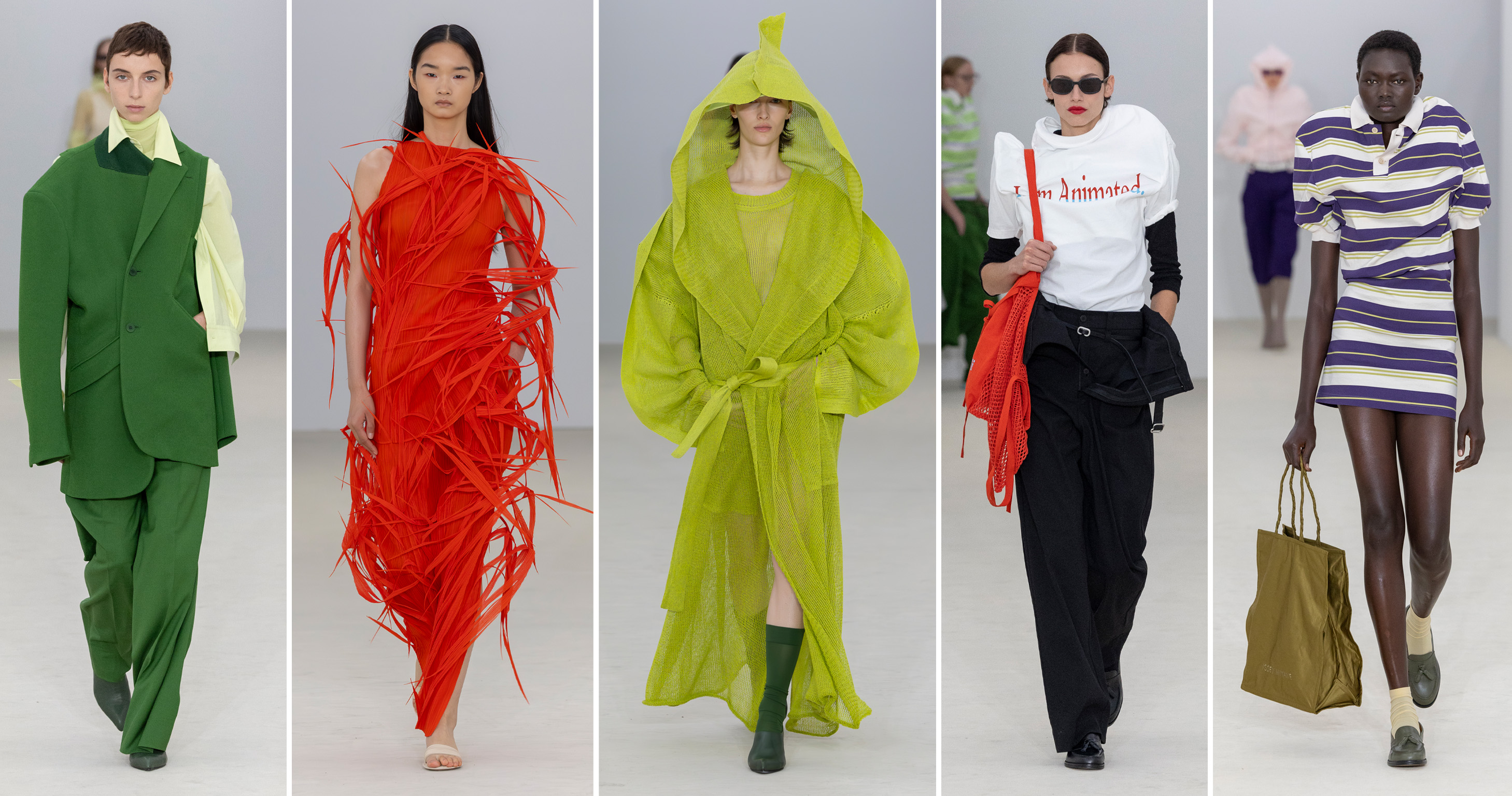
Issey Miyake
Satoshi Kondo’s collection, Being Garments, Being Sentient, explored the question: “What if garments are conscious?” Drawing inspiration from the unexpected, Kondo experimented with clothing having a conscious mind, each piece portrayed as if it carried a will of its own. Opening up a new relationship between the wearer and the worn. The idea for the collection encouraged the wearer to rethink familiar codes of dress: shirt sleeves were left to dangle free, a button-down shirt appeared left open at the back, blazers were stripped of an arm. Jackets were reimagined and recut into trousers, while graphic tees with statements such as “I am autonomous” and “I am animated” opened, followed by polo shirts and shrunken hoodies that bore protruding shoulders as if the wearer were mid shrug and trying to escape the garments. Tropical prints on draped dresses had a sculptural silhouettes, inside-out tailoring and beautifully draped cloak top and pants came in eye-catching colourways worn by models who moved to the rhythm of live soundscapes by Tarek Atoui.
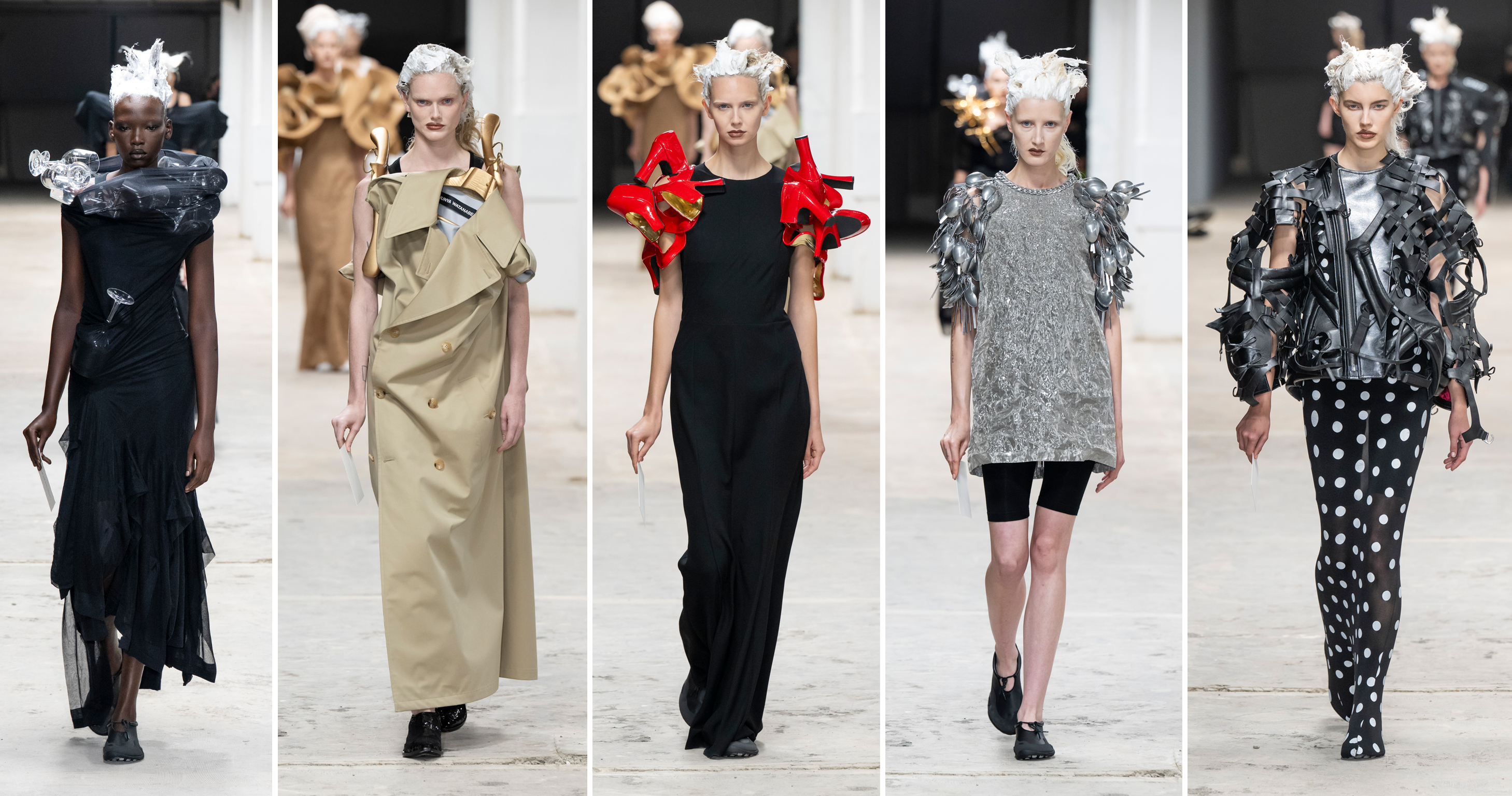
Junya Watanabe
Titled Extraordinary Art Born From the Everyday, Junya Watanabe explained in a brief statement: “I took a different approach to making clothes than before… and explored forms that could never be achieved through conventional methods.” Instead of the usual regular garments, he took objects like spoons, wine glasses and patent high heels as one of his materials and recontextualised them, exploring forms that leaned more towards performance art than fashion. Black stockings were stretched over a collar of wine glasses creating a whole new form, patent red heels were sliced in two and repurposed as cap sleeves on a tube dress. Similarly spoons formed the sleeves on a silver tunic giving the impression of chainmail armour. Trench coats and striped shirt dresses came on their hangers on the model’s bodies. Models paused mid runway to face the audience and hold up a white card with a description of the look, reminiscent of traditional salon shows. The final look fashioned his signature biker jacket from boxing gloves from Grit Fight Shop in Japan.
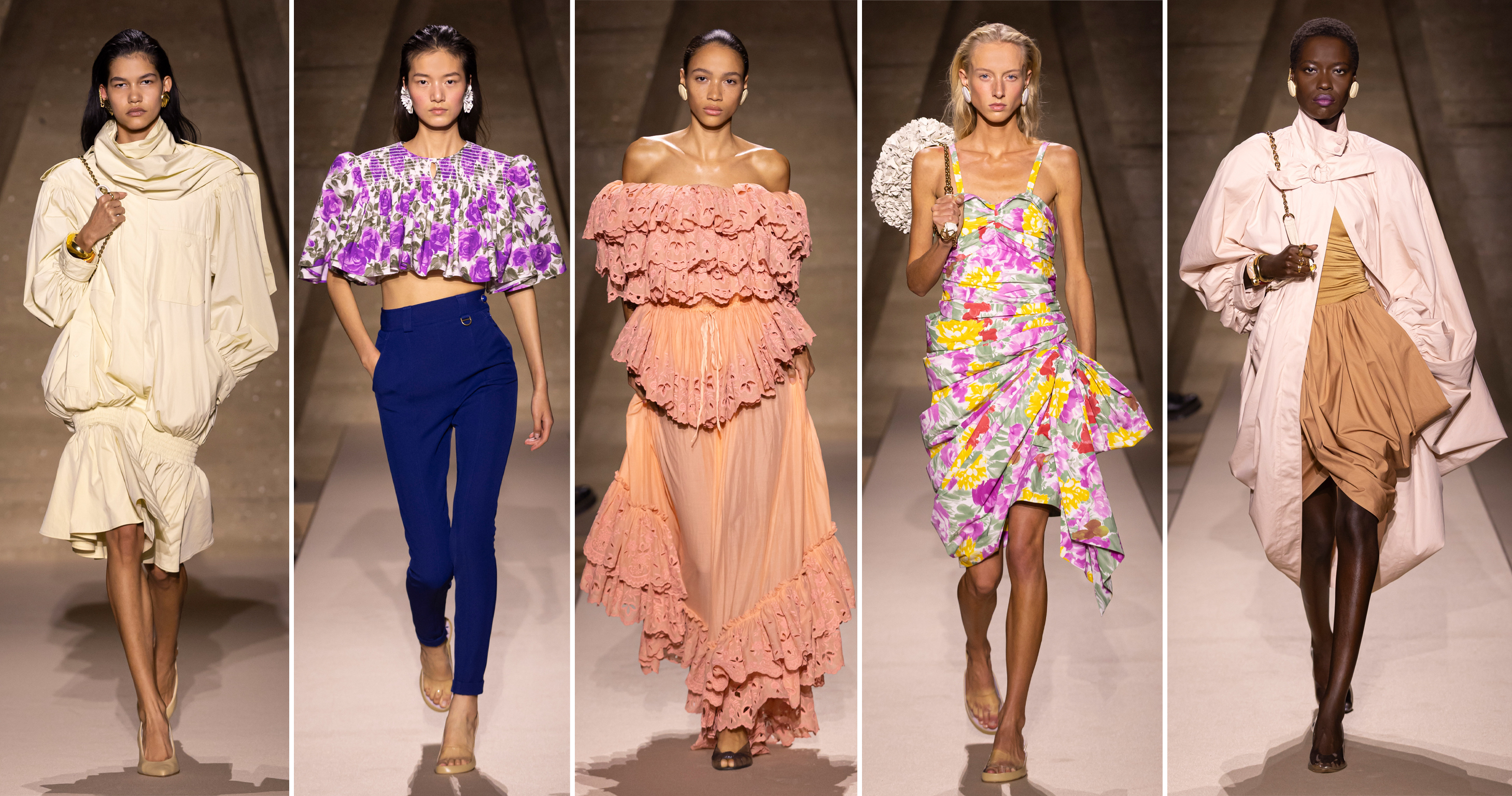
Chloé
In the late 1950s, the first Chloé collections were shown to journalists over croissants and coffee at Café Flore and Brasserie Lipp in St Germain. Chloé founder Gaby Aghion was inspired by the silhouette of couture, but minus the lining, padding or boning. Chemena Kamali took this spirit and floral archive prints from the 1950s and 1960s for her SS26 collection. Think the kind of splashy rose prints seen on swimwear of the era; the shape of the top of the sundresses also came from retro bathing suits. Kamali used a draping technique to create volume and movement. Reworking outerwear archetypes in light swathed cottons giving them an 80s silhouette. The mood was light and uplifting, further fun elements came in a flamingo-print body suit, a swan-shaped bag and the squishy round bags inspired by retro swimming caps covered in cut out leather flowers.
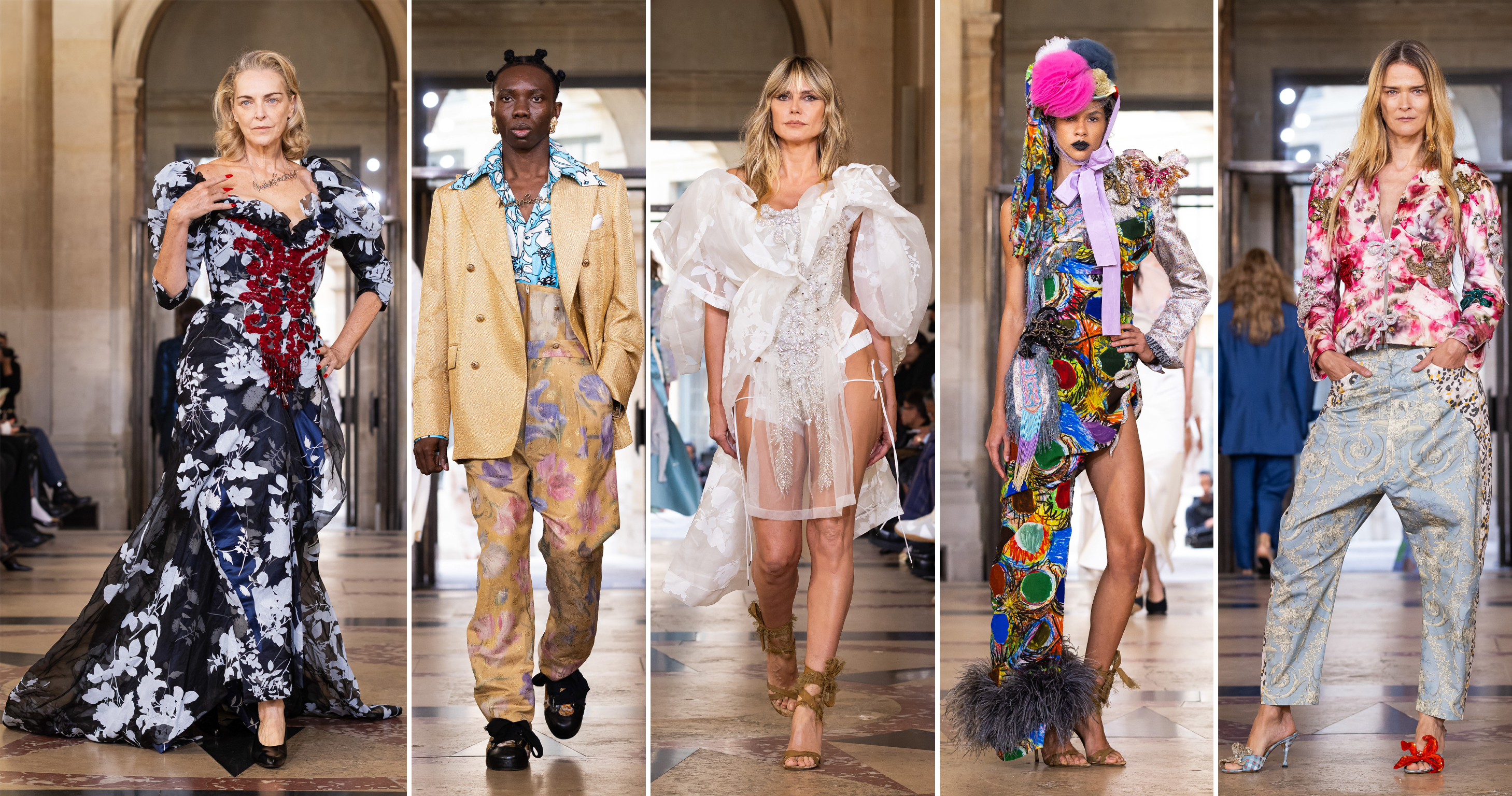
Andreas Kronthaler for Vivienne Westwood
The collection took its name from a newly relaunched fragrance - Boudoir, inspired by the old perfumes of Versailles loved by Westwood and Kronthaler. A huge spinning vase of sunflowers topped with a yellow umbrella (from Cherbourg, of course) separated the two sections of the runway at L’Institut de France. In an email message to guests, Kronthaler stated: “There are lots of sunflowers on our studio terrace in London and every time I look at them, they make me smile.” The same can be said of a Westwood show, the pure theatrics never fail to raise a smile from the audience. Which was a star studded affair: Ice Spice, Demi Lovato, Paris and Nicky Hilton sat front row and Heidi Klum made a catwalk cameo as the finale bride in a dress without a skirt that nodded to the boudoir theme. Key looks included a colourful dishelleved mishmash sunflower dress, a corseted gown with a floral silhouette print and an embroidered bodice and a high-waisted men’s tailoring. Kronthaler has relocated to Milan and holidayed this summer on an island off Sicily. “I wanted to capture the spirit of the Mediterranean,” he said, “I fell in love with these typical Italian fabrics that you would find in markets everywhere. We combined them with iconic prints of the house.”
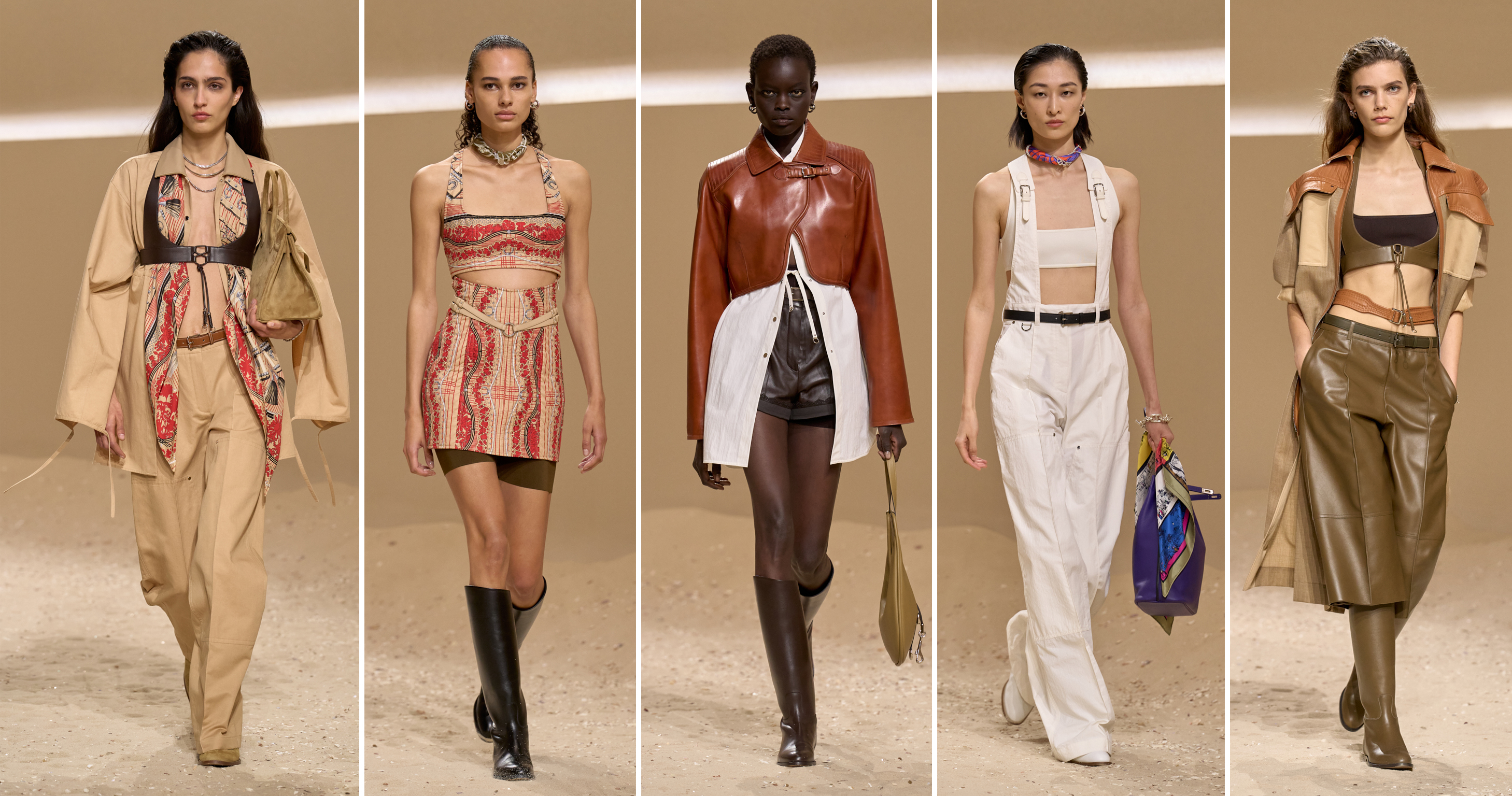
Hermès
Camargue is a coastal region in southern France between the Mediterranean Sea and the two arms of the Rhône river delta, famous in part for the white horses that roam the marshlands that require a specialist saddle to ride. A visit to the Hermès archive and the discovery of an antique Camargue saddle, set creative director Nadège Vanhée on her design path for SS26. Equestrianism is at the heart of Hermés’s heritage, the signature high backrest of the archive Camargue saddle patinated by the elements and shaped by horse and rider informed the curved lines and colour palette of the collection; mainly comprising shades of brown and sand leather. The free-spirit of Vanhée’s imagined horse-woman adventurer embodied the collection. Corsetry-inspired quilted dresses were worn over cycling shorts, cotton dungaree-inspired trousers with harness straps details echoed equestrian precision. Tops were fashioned from printed silk scarves caught under a cutaway leather bralet and quilting referenced horse blankets. All looks were worn with riding boots.
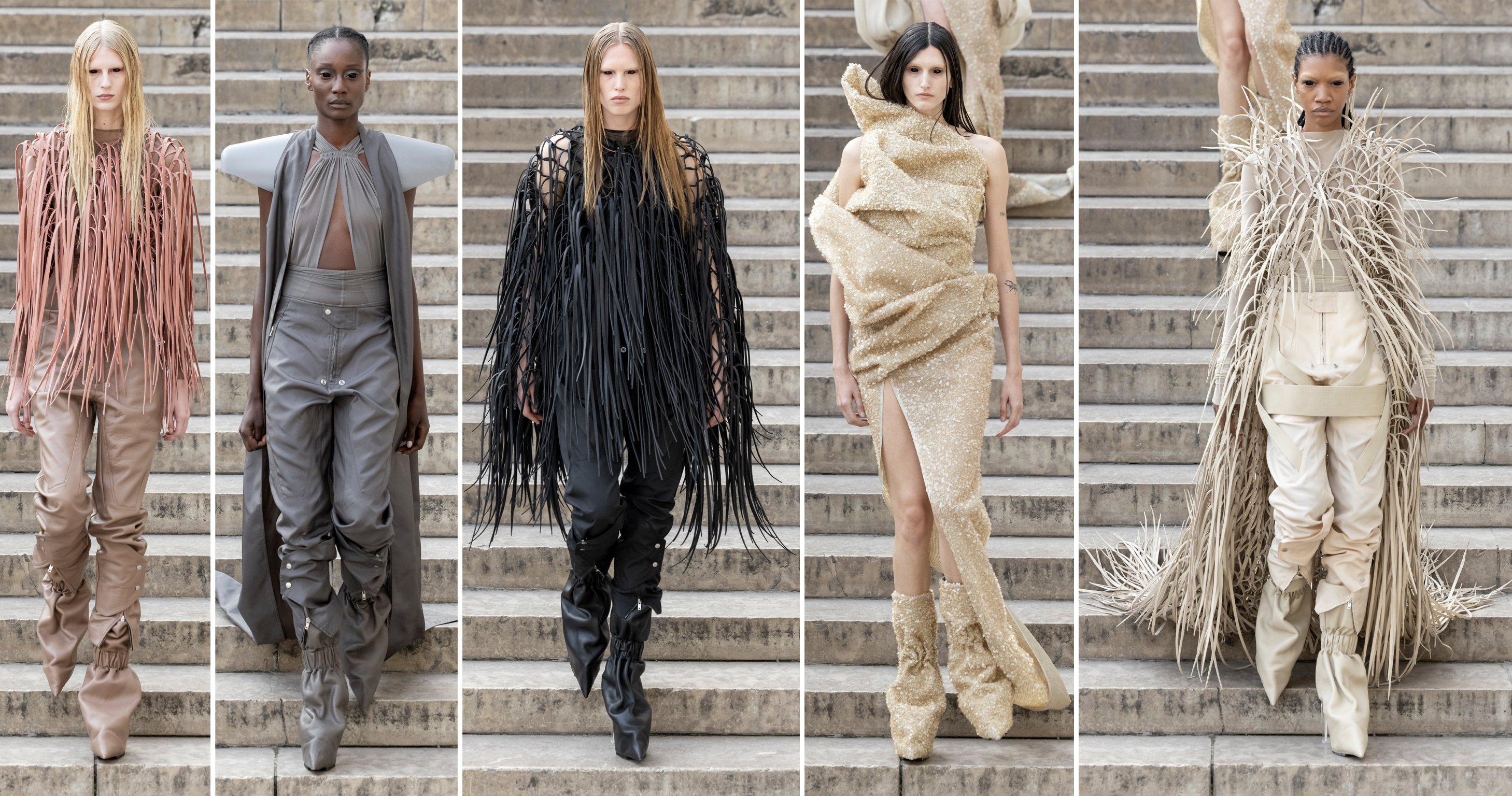
Rick Owens
SS26 saw the second chapter in Rick Owens Temple collection. Following on from his men's show in June, the title coincided with the opening of Owens’s retrospective Temple of Love at the Musee Palais Galliera in the summer. As with previous seasons, the show took place around the Palais de Tokyo fountain, models climbed down metal bleachers and waded through the knee-high water. The collection fell between toughness and fragility, with all the label's signature designs appearing in waves of muted colours. Familiar willowy silhouettes and exquisite sculptural draping, some layered with shimmering sequins, others slashed with geometric seams that bisected the body. Toughness came as cropped trenches with matching long vests, jackets and coats with exaggerated shoulders and fringed leather capes worn with platforms that elongated the body. Owens ended with a finale that saw models en mass return to the fountain, while jets of water shot more than 20ft into the air around them.
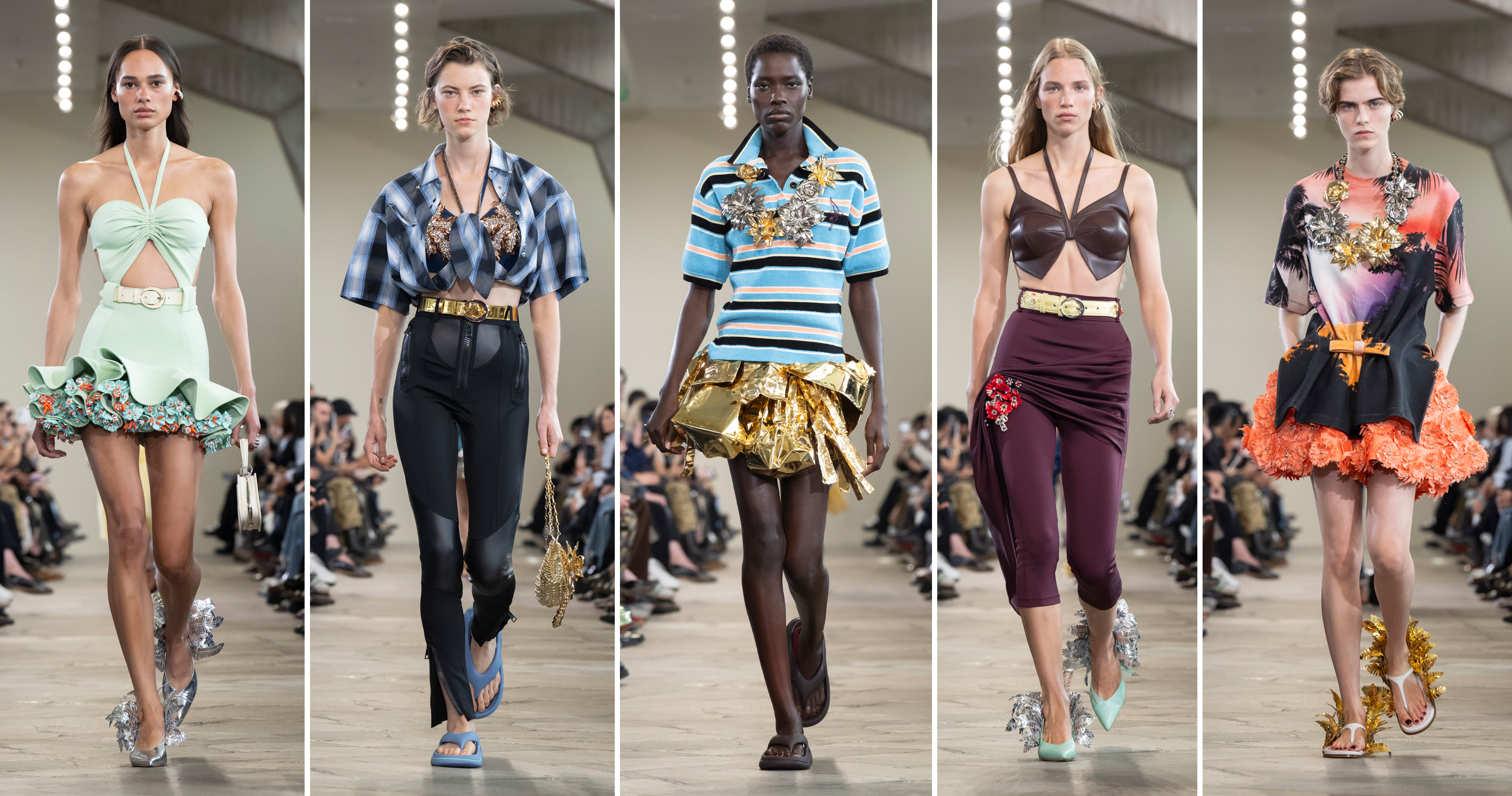
Rabanne
Beachwear was a recurring theme at Paris fashion week, so too was the neoprene wetsuit, used as a source of inspiration by Julian Klausner at Dries Van Noten and referenced by Julien Dossena at Rabanne. “I grew up in Brittany by the sea and wanted to have that feel, that beachy, improvised feel of dressing,” he said. Dossena wanted the clothes to feel laid-back, but still have that element of glamour, which came from 1950s bathing beauties. The lineup of looks included fashioned bikini tops worn on their own or visible under dresses with ruffled edges or layered under vibrant flowery blouses worn with flowing skirts. Wetsuit inspired zip-front neoprene pants came folded over at the waist, Tropical decorated T-shirts were worn with deconstructed, leg-exposing short skirts that draped in gathered trails. Flouncy hemmed skirts and dresses, some with tactile flower underskirts inspired by 50s swim caps were joyous, so too was a casual striped polo shirt that came with a “car crash skirt”, as described in Dossena's show notes, consisting of tiers of metal assembled into a wearable sculpture that clanked with each step.
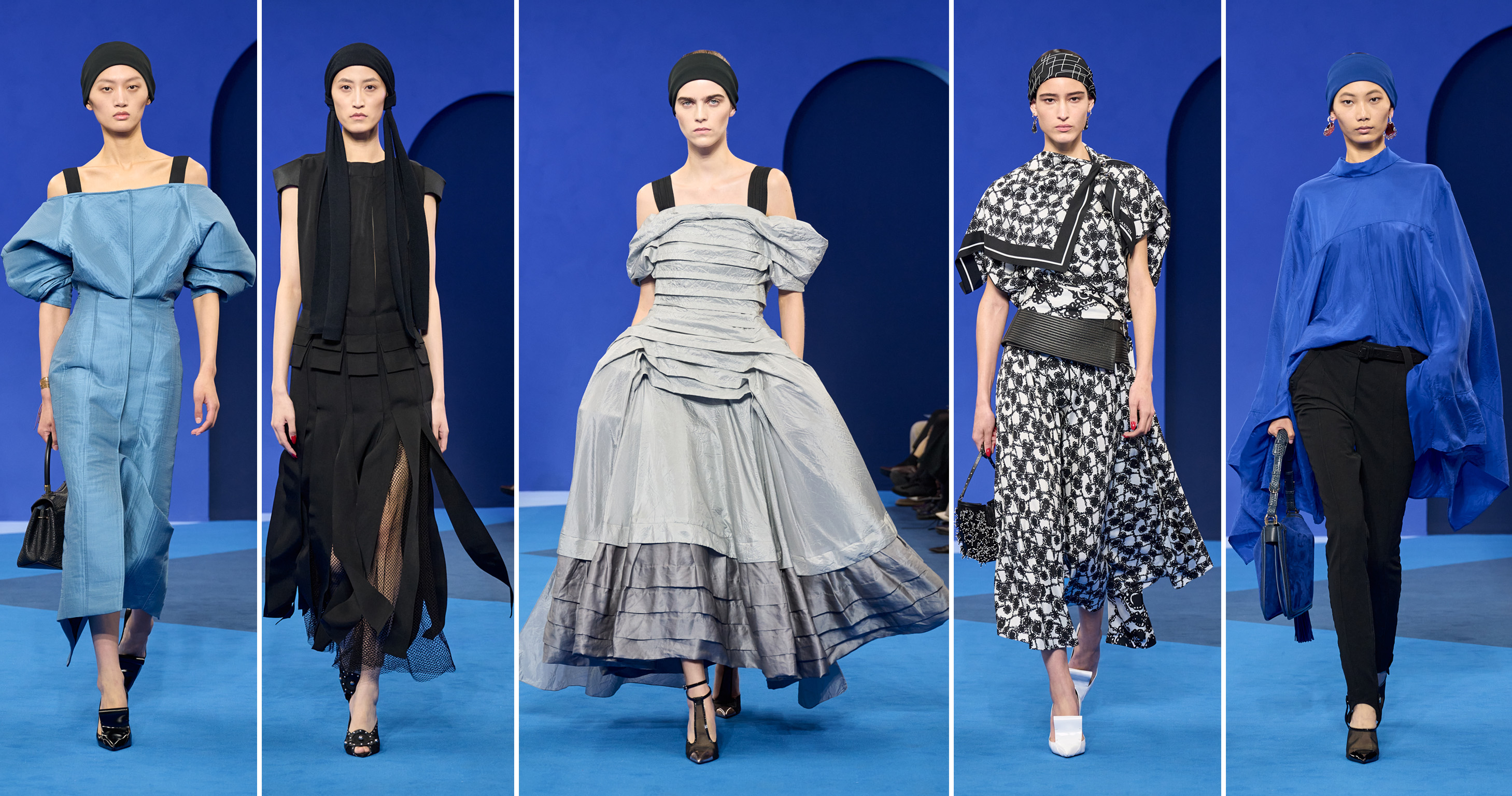
Lanvin
Peter Copping joined the French heritage house in September last year as artistic director. The seasoned designer, known for his ultra feminine designs, reimagined the house codes, taking inspiration from the brand’s history. A year into his tenure the new collection included a series of art deco-inspired looks referencing Jeanne Lanvin’s blue-washed, 1920s apartment, including seamless shirting, tailored trousers, puffed-out skirts, and two-piece knitted looks, some featuring sharp, geometric patterns decorated in crystals or mixed with contrasting fabrics. Tones of blue ran throughout the entire collection from sleek suits, belted trenches and sheer tiered dresses and slouchy eveningwear, all came in differing shades of the colour. Copping reinterpreted scarf prints in asymmetric fluid cuts, while there were moments that touched on the late, greatly missed Alber Elbaz, such as the grosgrain ribbons used to tie the backs of dresses or suspend a full-skirted dress from the shoulders, or simply flow as fringes.
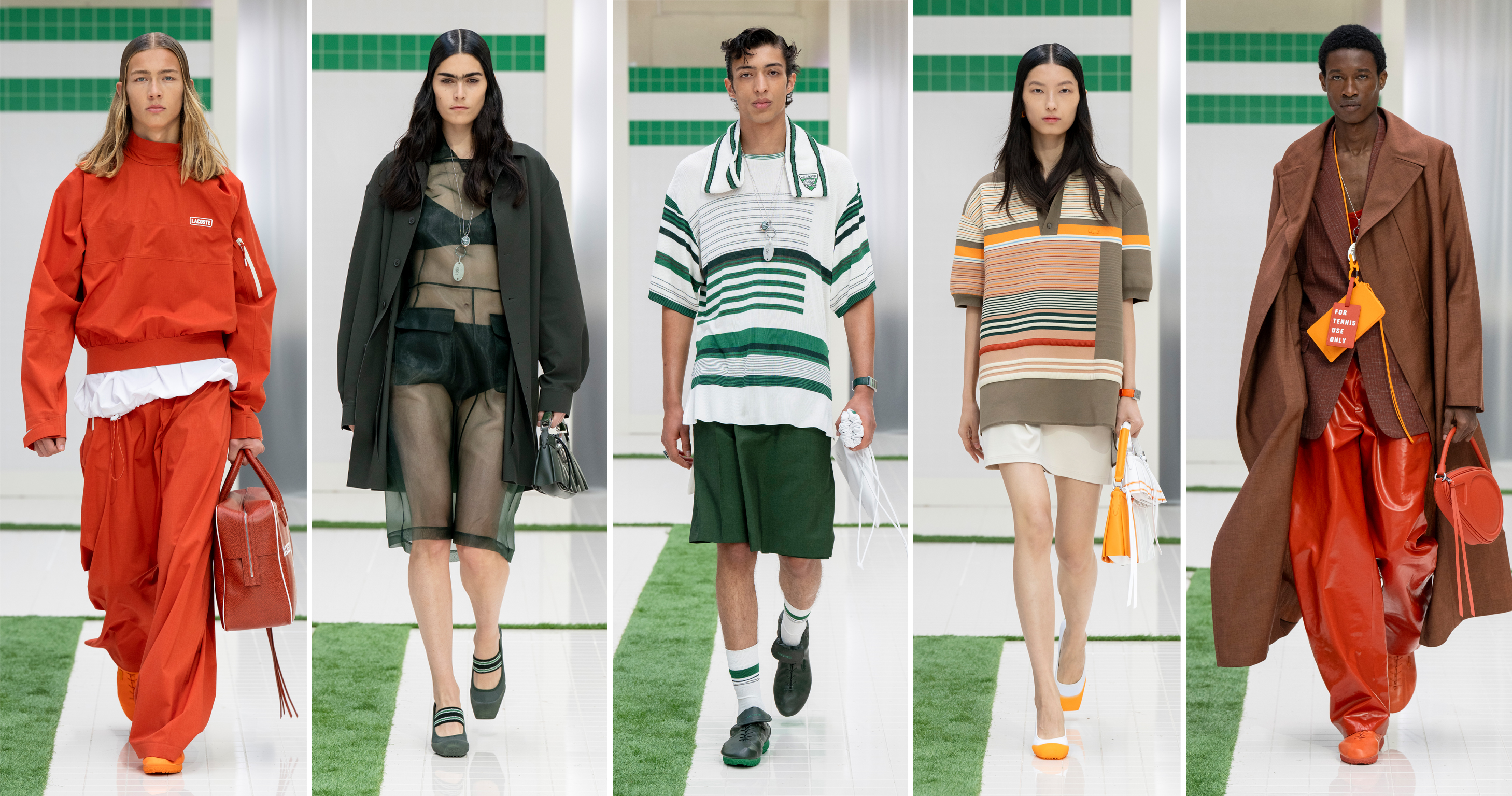
Lacoste
Lacoste transformed the Hall Eiffel at Lycée Carnot into a locker room for the SS26 show. Guests including Anna Wintour and actors Michelle Williams and Adrien Brody sat on seats fashioned from stacks of towels. The all-encompassing theme extended to the silver travel soap dish invitation. Creative director Pelagia Kolotouros embraced the locker room as a liminal space between the rush of triumph and the quiet reckoning of defeat. Fabrics were inspired by the locker-room environment, transparent organza evoking shower curtains, towelling fabrics and reflective leather. Further inspiration came via brand founder René Lacoste, think athletic heritage remixed with vintage sportswear; robe-like trench coats emblazoned with “Tennis for Everyone”; striped knits that riffed on match polos and wide-leg tracksuits with vintage sportswear accents in a retro colour palette of orange, green, blue and taupe. Loose tailoring came in tropical wools and mohair styled with fly-away nylon and leather.
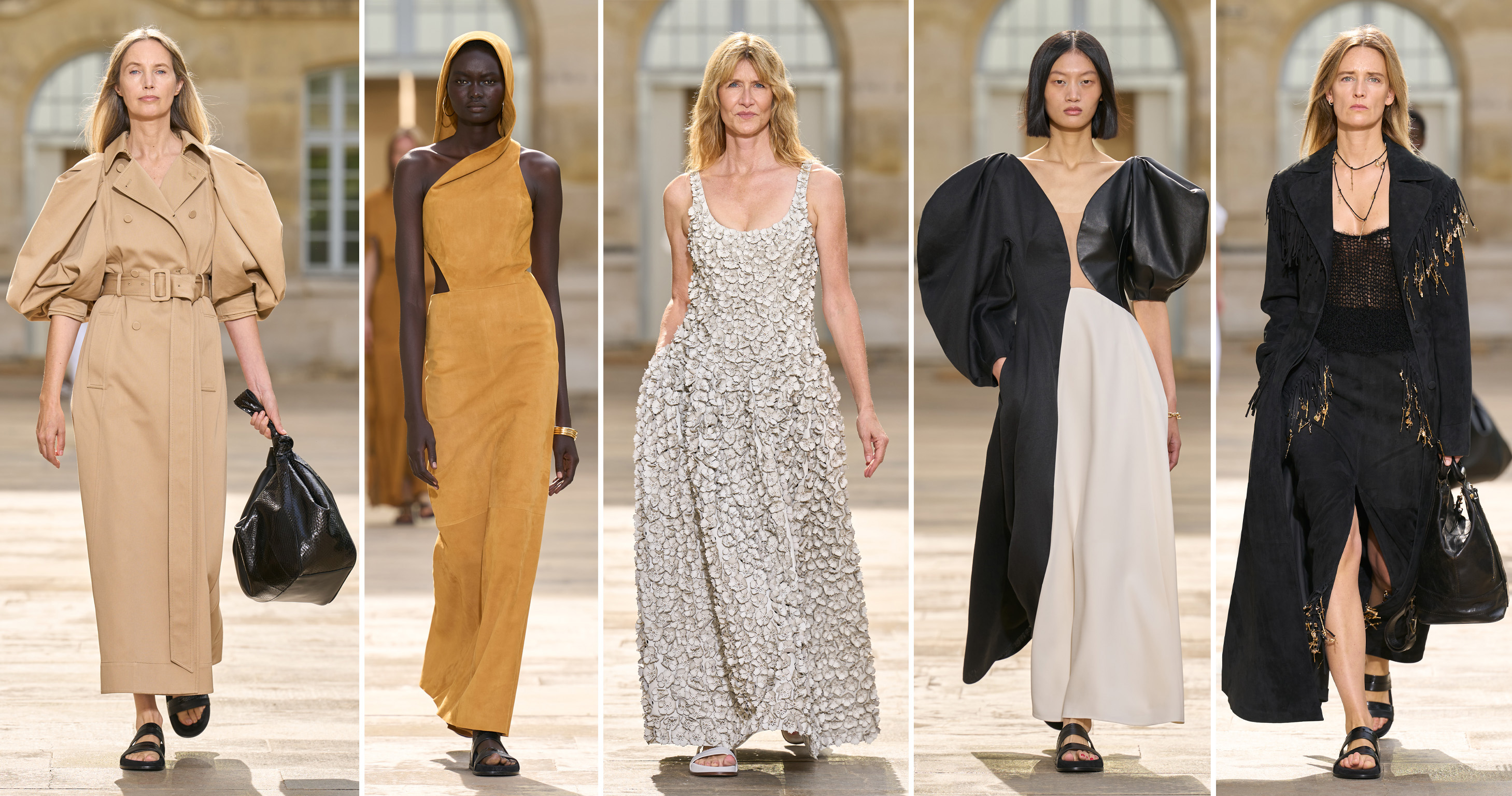
Gabriela Hearst
“I have always been fascinated with Tarot, my mother gave me my first tarot at 18,” shared Gabriela Hearst in her SS26 show notes. Taking inspiration from the 22 Major Arcana cards that represent significant life events, archetypes and spiritual themes via characters, including a magician, a high priestess and ending on the hanged man. Actor Laura Dern opened the show in a dress referencing the Empress card made from craft technique that saw 2,500 leather flowers applied to a white leather full-skirted dress. Hearst also named her latest bag, the Dern, after the actor. As always the collection featured deadstock materials from previous seasons, natural fabrics, such as cotton, linen and leather, created voluminous silhouettes, puff sleeves on coats, blouses and dresses. Detailing came by way of gold charms – a moon, skull, cup and wand, hung from the fringe of skirts and suede coats and strung on to silk necklaces handmade by the design team in the Hearst’s studio.
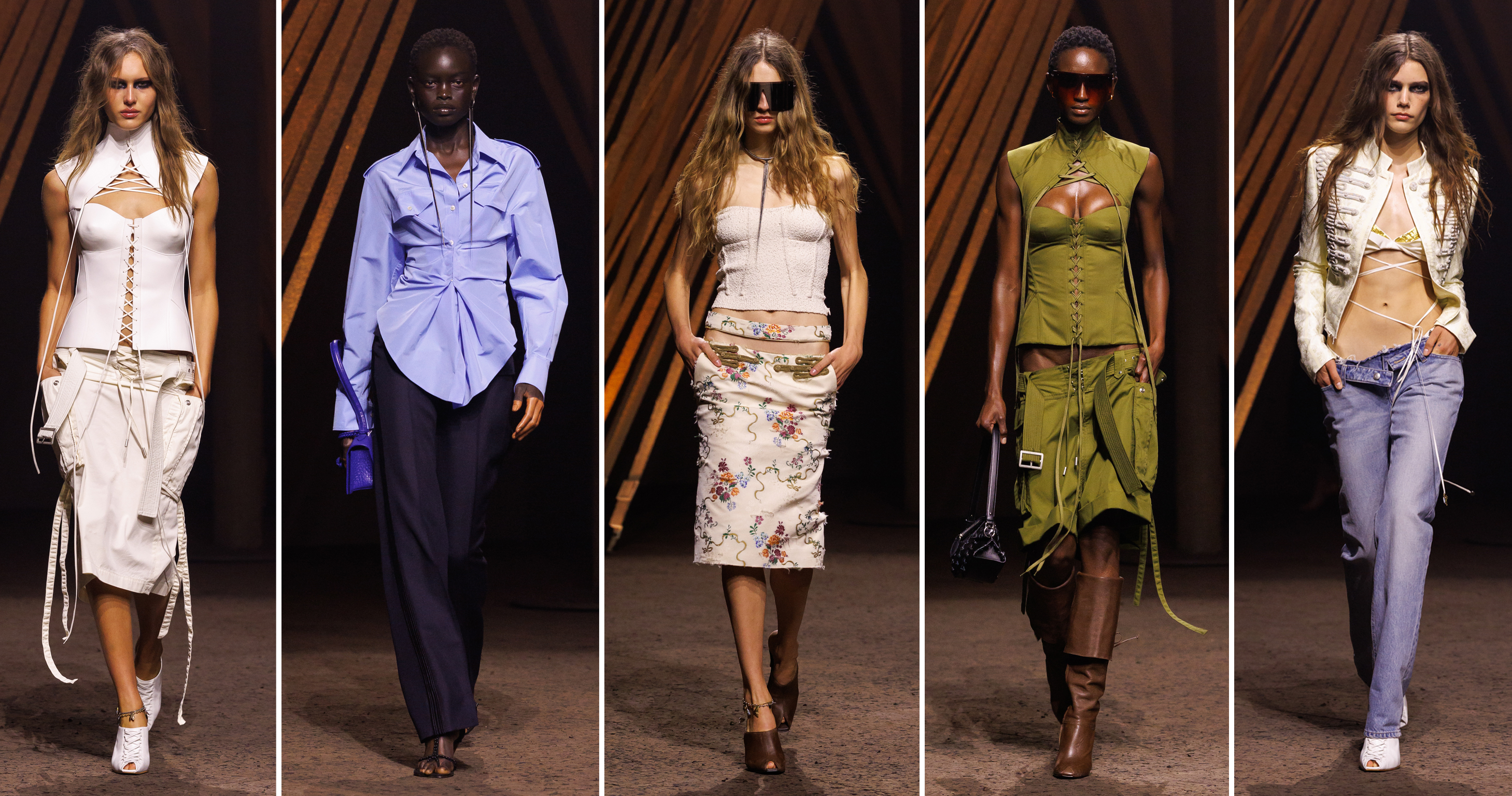
McQueen
For SS26, creative director Sean McGirr looked to a favourite movie, 1973 British folk horror film The Wickerman, directed by Robin Hardy for his inspiration. A maypole-like structure formed the centre of the Tom Scutt-designed set, made using 8,000m of hessian ribbon and a maypole crown crafted by the Armagh Rhymers, an Irish folk group (McGirr hails from Dublin). The Armagh Rhymers also made hundreds of harvest knots distributed to guests with their invitations. Uniform fabrics and finishings applied to slashed bustier dresses and blue shirts riffed on the policeman character Edward Woodward played in the film. The technical tailoring McQueen is known for featured heavily. The collection was littered with archive references, including the infamous bumster trousers, first shown by Alexander McQueen over 30 years ago and now finding a place again with Gen Z. The waistband is cut precariously low to reveal the top of the wearer’s bottom. The shock value of the original has dissipated in the intervening years, in today’s world they seem almost tame.
